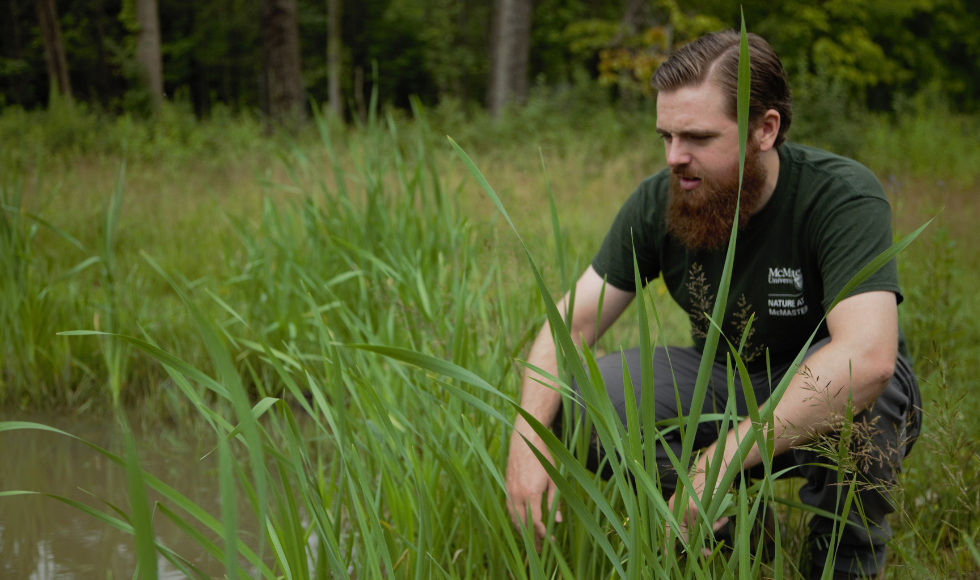Science PhD student helping unpave paradise with ponds

Noah Stegman, McMaster’s coordinator of natural lands restoration and conservation, led a project that saw five vernal ponds added to West Campus.
Noah Stegman couldn’t believe what he saw at McMaster’s latest environmental restoration project.
Five vernal ponds were added to the West Campus last November — Stegman oversaw the project as McMaster’s coordinator of natural lands restoration and conservation. The ponds are on a strip of land between the baseball diamonds and where Cootes Drive bends towards Dundas.
The shallow seasonal ponds were designed to fill with melting snow, spring rain and groundwater and then dry out. That makes it the perfect habitat for amphibians and insects — there’s no risk of getting eaten by fish.
Stegman visited the ponds in early April with low expectations. It had been a warm, nearly snow-free winter. And it usually takes a few years before amphibians move in and make themselves at home. But the ponds were full of water and teeming with life. There were frogs, toads and tadpoles galore. “I was surprised at how quickly the ponds had started working. They were way ahead of schedule.”
The ponds are part of the ongoing restoration of the West Campus. The area where hundreds of commuting students, faculty and staff park their cars and play slow pitch was once wetlands with a creek and floodplain. It was also home to the Coldspring Valley Sanctuary, a popular destination with its bird diversity and wet woodland habitat. Visitors were welcome to walk the trails but were reminded not to enter with “an axe, a gun or a dog unleashed.” There was an elm-ash woodland, dense vine tangles, open grassland and a bird food plantation.
McMaster began buying the sanctuary lands from the Royal Botanical Gardens in 1963. To make way for surface parking, the forest was eventually cleared and the Ancaster/Coldwater Creek was redirected. Parking Lot M and the Facilities Building opened in 1974, followed by Lot P. The vernal ponds are located on a wetland that was filled in decades ago and then forgotten.
Restoration of the West Campus started around the same time Stegman joined McMaster as an undergraduate student in 2014 taking Earth and Environmental Sciences with minors in biology and geographic information systems. He remembers only going outside for a single lecture, even though the campus is surrounded by nature.

All that’s changed for Stegman as he earns his PhD in Earth and Environmental Sciences. He’s the graduate representative on the President’s Advisory Committee on Natural Lands and McMaster’s representative on two subcommittees with the Cootes to Escarpment EcoPark System. He manages trails for the McMaster Forest and supervises a crew of student interns. He’s also the Coordinator of Nature at McMaster and an advisor and former president of the McMaster Outdoor Club.
Working on restoration and conservation projects lets Stegman put his head, heart and hands to work. He also gets to consult and collaborate with campus and community partners who share his passion for conservation.
Those partnerships were crucial to building the vernal ponds, which were funded with a grant from the Parks Canada National Program for Ecological Corridors Cootes to Escarpment EcoPark System Pilot Project.
Approvals were needed from both the Hamilton Conservation Authority and Hydro One — powerlines cross over the ponds which meant trees were out and shrubs were in. An army of DeGroote commerce students helped with planting and clearing out invasive species.
Elders from Six Nations of the Grand River and Indigenous Studies faculty were also involved right from start as equal partners — McMaster is, after all, situated on traditional territories shared between the Haudenosaunee Confederacy and Anishinaabe Nations. “Too often, Indigenous communities are brought in as an afterthought on environmental restoration projects even though they are the original stewards of this land,” says Stegman. “We weren’t going to make that mistake in building the ponds.”
The project adhered to the Indigenous approach to restoring degraded lands. Instead of soaking the land with herbicides or stripping and ripping everything out to start over with a blank slate, restoration is gradual and builds on what’s already there. “You go with what the land wants and is telling you,” says Stegman.
While there were invasive species all around the ponds, Stegman says there were also a surprising number of native species — including a stand of rare grasses that are found in just two other locations in Hamilton.
Crews of student volunteers pulled out invasive species by hand and planted hundreds of shrubs and thousands of seedlings, including Indigenous cultural plants that will eventually be harvested.
The plan is to turn the five ponds and the surrounding land into an outdoor classroom and living lab for faculty and students with Indigenous Studies and in the Faculty of Science.
There are also plans to bring back a marsh just beyond the ponds that will provide another habitat for turtles.
Environmental restoration was only a whisper when Stegman joined McMaster 10 years ago. He says McMaster has embraced conservation and become a leader among universities. Lots of classes now routinely head outdoors. And there’s growing and sustained support for restoration projects.
“Lots of people want this work to succeed. I’m getting emails from people who walk, bike and drive past the ponds and appreciate what the university is doing there,” says Stegman. “McMaster has come a long way and I’m proud to have played a small part.”


